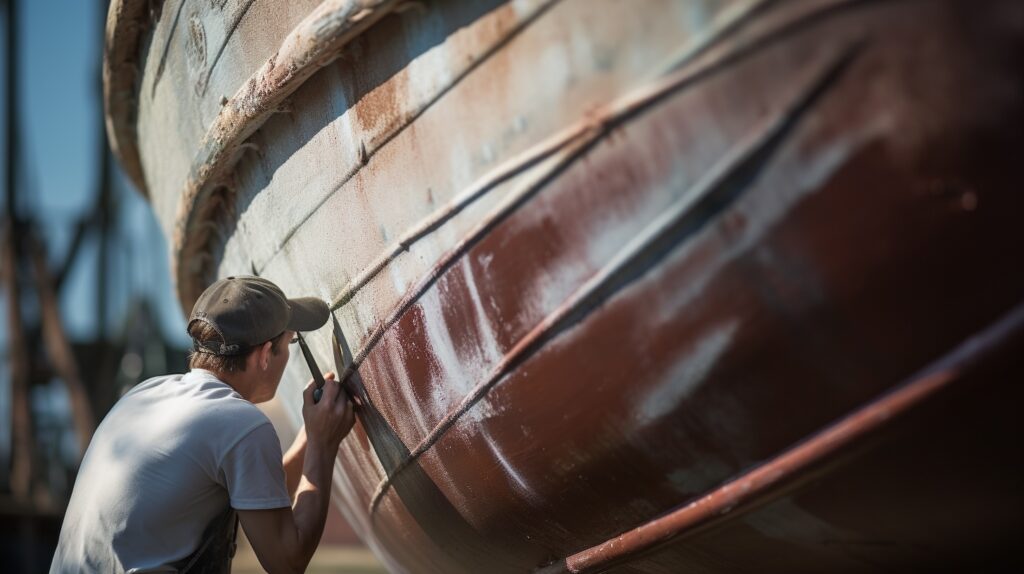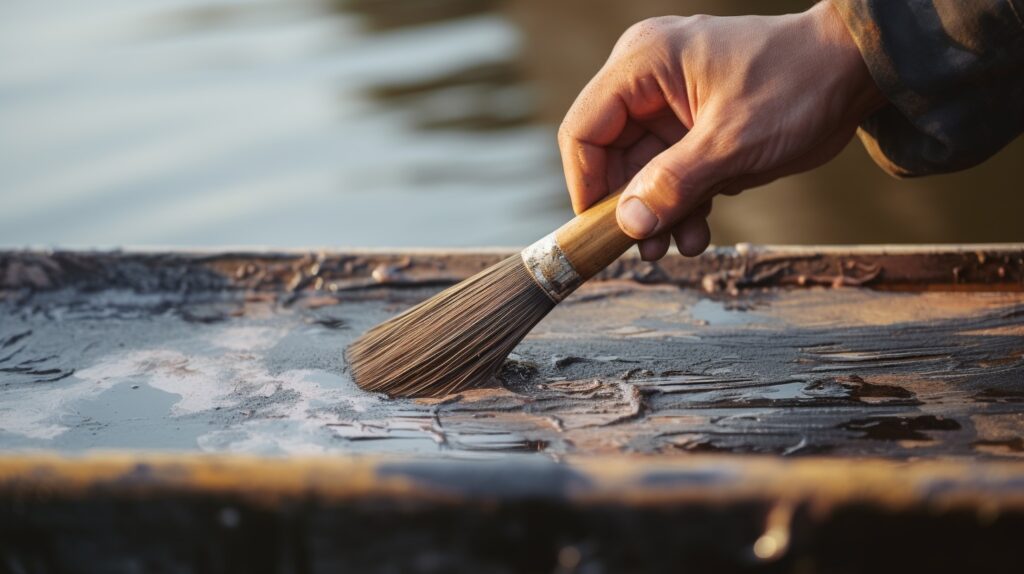Table of Contents
Table of Contents
How To Paint A Boat

Restoring an old boat or giving your current one a fresh look? Having trouble finding the right approach to paint it correctly? You’re not alone in this, as painting a boat can be quite challenging due to the choice of paints and techniques involved.
This article is designed to make the process simpler by providing step-by-step instructions on how you can prepare your boat for painting, select the right type of paint, apply it properly, and take necessary safety precautions.
Ready to embark on this DIY journey toward a newly painted vessel?
Key Takeaways
- Get your boat out of the water and clean its surface before you start painting. If it has cracks, patch them up first.
- Choose your paint wisely! Consider durability, shininess, and how good it is at blocking UV rays. Popular brands are Awlgrip, Interlux, and Pettit Paint.
- Use a brush, roller, or sprayer to apply the paint evenly onto the cleaned surface of your boat.
- Safety comes first when working with paints and tools. Always wear protective gear during the whole process.
Preparing the Boat for Painting

Start by removing the boat from the water and thoroughly cleaning its surface. Address stress cracks, patch where necessary, and sand with 80-grit sandpaper for a smooth finish. Lastly, don’t forget to remove any hardware to prevent paint mishaps.
Removing from the water
Pulling the boat out of the water launches the initial stage of the painting process. This crucial step paves the way for a thorough inspection and necessary repairs before moving to further cleaning steps.
It ensures a dry surface for successful paint adhesion, aiding in preventing resistance from elements that could degrade your fresh paint job. Dry docking also aids in complying with regulations that strictly prohibit in-water bottom cleaning or hull scraping due to environmental concerns.
Hence, having your vessel on land facilitates an efficient and clean work environment while preparing it for its transformation under your skilled hands.
Cleaning the surface
Thoroughly washing the surface of your boat is a crucial step in priming it for a fresh coat of paint. Ridding the fiberglass boat surface of dirt, salt, and grime that might have accumulated over time ensures a smooth painting process.
Using rough sponges and warm soapy water, scrub every inch intensively but with care to avoid causing any damage.
Post-cleaning comes the tedious task of sanding. Start by using 80-grit sandpaper to scrape off any loose paint or rust spots from the hull and topsides. If you spot any imperfections like chips or dings on your vessel, take this opportunity to repair them as well.
Achieving an even layer across the entire boat’s surface will allow for optimal adhesion when you roll on that first coat of marine paint later.
Sanding with 80-grit sandpaper
The transformation of your boat’s surface begins with sanding. Opting for an 80-grit sandpaper results in a clean and smooth canvas ideal for painting. This particular grain size scrapes away old paint layers, rough spots, and tiny blemishes effectively without digging deep into the fiberglass or damaging the gelcoat.
As you masterfully work the sander across every inch of your boat’s hull, small particles will inevitably disperse into the air — so using protective gear like goggles and masks is crucial to safeguard against inhaling dust particles, especially when dealing with older antifouling paint layers.
After thoroughly sanding down all reachable areas with 80-grit sandpaper, upgrading to a finer grade such as 120-grit before applying fresh paint creates an optimized adhesive surface that lasts longer and shines brighter after layering on your chosen polyurethane or enamel marine paint.
Bonus tip: remember to give extra attention to high-traffic topsides that can develop more significant wear over time!
For an excellent finish on bottom parts too prone to damage by salt water immersion and aquatic organisms, make sure you adhere strictly to preparation steps – this process which involves detailed epoxy primer application should not be bypassed if you want long-lasting gloss from your two-part polyurethane paint job; it requires some patience but bears fruit in preserving your beloved vessel while maintaining its buoyancy in style!
Dealing with stress cracks
Stress cracks are a common problem found in many older boats, especially around reinforcement ribs on the hull. The presence of numerous stress cracks often signals that the gel coat has exceeded its lifespan and is vulnerable to further damage.
Ideally, managing these cracks involves utilizing a Dremel tool with a distinctive metal bit to escalate them for repair purposes. Filling these areas with slick sand furnishes an effective solution before moving on to sanding and painting tasks.
However, bear in mind that this method primarily provides cosmetic relief, as the root cause might be excessive gel coat.
Patching
Patching requires careful attention to fix any surface imperfections on your boat. Start by identifying chips, dings, or gouges that may need repair before painting. Use marine epoxy, a durable compound ideal for fixing defects in fiberglass boats.
Apply the epoxy generously over the damaged area and allow it to dry completely. For best results, sand the patched areas with 300-grit sandpaper until smooth to the touch. After patching, ensure you have an even surface ready for a fresh coat of paint.
This step ensures your boat’s hull retains its structural integrity and enhances the final finish of your paint job.
Removing hardware
Begin the task by carefully taking away all major hardware pieces. This includes items such as rails, cleats, vents, and teak or wood trim. Conduct this operation with caution to avoid causing any damage to these components.
Store them in a safe place for re-installation after completing the paint job.
Addressing other surface features is also crucial before applying fresh paint. Chips, dings, or gouges can lead to uneven results and should be repaired ahead of time. A glossy or waxy finish on the boat needs thorough removal using rough sponges and specialized solvents like Awl-Prep.
This step ensures the new layer of paint adheres properly to your boat’s hull and topsides for a perfect coat that not only looks great but lasts longer too.
Choosing the Right Paint

Selecting the right paint for your boat is crucial. It’s important to familiarize yourself with the different types of marine paints available in the market. Factors like durability, gloss retention, and resistance to UV rays should be considered while making a choice.
Not all paint brands are created equal; hence quality matters. Some recommended brands include Awlgrip, Interlux, and Pettit Paint due to their proven performance on fiberglass boats.
Types of paint for boats
Choosing the right paint type for your boat is crucial to ensure a lasting finish. Here’s a quick rundown:
- One-part polyurethane: This is a marine topside paint suitable for any general boat painting project. It’s easy to apply with good gloss and durability.
- Two-part polyurethane: This paint achieves the hardest finish, greatest longevity, and highest gloss. Boats painted with this are often mistaken for newly gel-coated ones.
- Alkyd marine enamel: Often used on commercial ships and fishing vessels, this paint provides excellent weather resistance at an affordable cost.
- Buffable two-part polyurethane: Known for its buffability, this glossy and durable paint gives boats a sleek, shiny finish.
- Specific topside fiberglass paints: If you own a fiberglass boat, using this specially designed topside paint will give you the best results.
- Aluminum or galvanized steel recommended paints: To protect your aluminum boat, it’s vital to use the manufacturer-recommended topside paint formulated especially for these kinds of materials.
- Hard bottom biocide-rich paints: Perfect for those frequently-used boats spending lots of time in the water as it resists algae growth and other water-borne issues efficiently.
- Environmentally-friendly hull paints: These alternative coatings are cost-effective substitutes to traditional copper-based antifouling paints that still maintain efficiency while reducing environmental impact.
Factors to consider
To pick the right marine paint for your boat, multiple factors must be considered. The type of water conditions where your boat will sail plays a significant role in the selection process.
Freshwater bodies and saltwater oceans or seas have different effects on boats, influencing the choice of anti-fouling paint you should use to protect from aquatic organisms that might affect the hull’s performance and longevity.
Your boat type is another crucial consideration since every vessel requires a specific kind of paint due to unique design features and materials used in their construction. Moreover, compatibility with existing paints is important as certain fresh layers may not work well with what’s already on board.
Also, using an epoxy primer before applying topcoat ensures good bonding while enhancing durability against harsh weather conditions or accidental knocks at docksides.
Quality of paint
The quality of paint is a vital factor when deciding on the right type for your boat. High-quality paints last longer and provide better protection against harsh marine environments.
Two-part polyurethane paints, despite previous compatibility issues, are recognized for their superior gloss and durability compared to single-part enamels.
Ablative bottom paints, for instance, offer ongoing antifouling benefits which add to their demand among boat owners. Alternatively, copper-free bottom paint has emerged as an eco-friendly and cost-effective option that doesn’t compromise performance.
This means you don’t have to choose between protecting your boat or preserving the environment; you can do both with high-quality paint!
Recommended brands
Interlux stands tall among the best bottom paint brands for boats, offering long-lasting gloss and superior protection. They’ve earned trust with their specialized formulas for fillers, primers, and additives that keep your boat looking great.
Awlgrip’s two-part polyurethane paint is a favorite of many boat owners due to its outstanding durability and gloss retention. For topside painting, there couldn’t be a better choice than epoxy primer from TotalBoat which offers excellent adhesion to fiberglass surfaces.
The one-part enamel paints from Rust-Oleum are easiest to apply making them ideal for DIY enthusiasts willing to handle their prep work. Last but not least, Pettit Marine Paint has won accolades too with its anti-fouling selection meant specifically for hulls dealing with aquatic environments.
Applying the Paint
Once you’ve picked your paint, explore different application methods such as using a roller, sprayer, or brush. Follow the step-by-step instructions carefully to ensure even coverage.
Try out the roll and tip technique for a smoother finish and learn tips to avoid runs in your paint job.
Methods: roller, sprayer, brush
When it comes to painting a boat, there are three main methods you can use; these include using a roller, sprayer, or brush.
- Roller Method: This technique often involves the “roll and tip” approach popular among many boat owners. Here, one person initially rolls on the paint while another follows up with a dry brush to smoothen out any inconsistencies. Apt for large surface areas, this method is heralded for its ability to produce smooth and glossy finishes when paints like Brightsides are used.
- Sprayer Method: A relatively quicker method of applying paint is through spraying. It covers larger areas in a short time and provides an exceptionally even finish if done correctly. However, adequate precautions must be taken due to potential inhalation risks.
- Brush Method: This traditional method might require more time than others but offers greater control over detail work and hard-to-reach places on the boat’s hull. For best results especially on aluminum boats, use a natural hair brush.
Step-by-step instructions
To achieve a glossy, long-lasting finish when you’re painting your boat, follow these vital steps:
- Find a clean and well-ventilated location to paint your boat ensuring no dust or dirt will stick on the fresh paint.
- Thoroughly wash the boat’s hull using rough sponges to remove any debris or waxy coating.
- Sand down the surface of your boat using an 80-grit sandpaper for fiberglass boats, or a random-orbit sander for aluminum boats. This is done to get rid of old paint and to give the new coat something good to adhere to.
- Remove all loosened paint particles from the hull by rinsing it with water.
- Dry the surface completely before proceeding with a primer application for improved paint adherence.
- Apply a layer of primer evenly across the boat’s surface, taking time to let each layer dry before applying another one
- Once your primer is completely dried, start painting using either a roller brush, spraying technique, or roll and tip method depending on which one you plan on doing.
- For better results, consider working with two-part polyurethane paints where one painter rolls on a coat while another follows up with a dry brush and “tips” it out.
- Let each coat of paint dry thoroughly before moving on to the next one; typically three coats of paint need to be applied for best results.
- After everything is properly dried, apply protective coatings such as topcoat or wax for added durability and luster.
Rolling and tipping technique
The rolling and tipping technique proves invaluable for painting a boat. First, a very short nap roller applies the paint on the surface of your prized vessel. This should be carried out by one person to maintain consistency of application all through.
Next comes ‘tipping’, which involves lightly dragging a dry badger-hair brush horizontally over this freshly painted area. It’s a smooth move that aids in the spreading and leveling of the paint, providing an elegant high-gloss finish as it dries.
For top-notch results, especially with Brightsides paint, look no further than this tried-and-tested method. Trust us when we say your boat will thank you with its gleaming hull reflecting proudly in the sun!
Tips for avoiding runs
Perfect painting conditions are essential to avoid runs. Aim for a medium temperature, low humidity day with minimal wind for the best results. Apply several light layers of paint rather than one thick layer as this will aid in smoother application and prevent paint from dripping down the boat’s surface.
It is also vital to apply primer before painting because it helps improve adhesion and reduces the chances of cracking. Immediately remove the masking tape after completing each section to ensure sharp edges without smearing or dragging undried paint.
Safety Precautions
While painting your boat, don’t overlook safety precautions – from wearing protective gear to ensuring proper ventilation and adhering to fire protocols. Discover more about how you can efficiently handle paint and maintain a safe environment during the process.
Protective gear
Proper protective gear is crucial when painting a boat to guarantee safety and ensure the job goes smoothly.
- Start with Tyvek suits and gloves. These are essential for safeguarding the body against water, oil, and dust during the process of boat painting.
- Consider wearing respirators. Boat builders highly recommend them due to the toxic nature of paints and solvents used in boat painting tasks.
- Don’t forget about your shoes. Protective impermeable covers over your footwear can keep paint spills at bay, while slip-resistant soled boots prevent any unfortunate falling incidents.
- Always wear Personal Protective Equipment (PPE). This gear is an absolute necessity for painters who want to avoid experiencing short-term irritation or long-term health risks caused by exposure to harmful substances.
- Opt for Tyvek coveralls if possible. Known for providing superior protection from airborne hazards, these coveralls are a popular choice among professional painters and DIY enthusiasts alike.
Proper ventilation
Proper ventilation stands as a crucial safety factor while painting your boat. Paint fumes, especially in confined spaces like the bilges of your boat, can pose significant health risks and may lead to severe sickness or even death.
To ensure safety during this process, adequate airflow is mandatory – it helps dissipate hazardous vapors and improves the overall air quality where you’re working. Moreover, employers involved in professional boat painting services need to abide by specific regulations about ventilation to protect their workers from harm’s way.
A well-ventilated work area combined with suitable respiratory protection minimizes the risk of inhaling harmful paint fumes during the painting operation.
Handling and disposal of paint
Managing paint waste is crucial to environmental safety and workplace cleanliness. Used paint cans should be sealed tightly and stored in a well-ventilated area to prevent fumes from spreading.
Never dispose of leftover paint in drains, toilets, or water sources since this can harm marine life. Instead, you can recycle the unused portion by taking it to local recycling facilities or hazardous waste collection sites where professionals handle proper disposal methods.
Regular inspections ensure that safe storage procedures are followed and help keep your workspace free from potential fire hazards caused by improperly handled petroleum-based products such as paints and solvents.
By embracing these practices, we contribute significantly to minimizing nonpoint source pollution associated with boat maintenance tasks.
Fire safety
Fire safety plays a critical role in the process of painting your boat. Flammable paints and coatings pose significant risks, leading to potential fires and explosions if not handled with care.
You must maintain a well-ventilated workspace to dissipate harmful fumes that can ignite easily. Equipping yourself with appropriate fire extinguishing equipment is also crucial, as fiberglass boats tend to burn quickly while producing toxic smoke.
A single spark can turn an ordinary paint job into a disaster; therefore, always prioritize fire safety when undertaking any boat painting project.
Using ladders or scaffolding
Climbing up on ladders or scaffolding is often necessary when painting taller boats. Ensure your ladder is secure and stable before you start any work. It shouldn’t shake or wobble as you climb, which could not only disrupt your paint job but also pose a serious safety risk.
Scaffolding can provide an additional level of security and comfort during the painting process, especially over precarious edges where balance may be compromised. However, use extreme caution when using these tools in adverse weather conditions like storms or high winds, which can topple even the sturdiest structures.
The key to a successful paint job on a boat with ladders or scaffolding lies in safe conduct and adherence to guidelines; taking shortcuts could lead to disaster.
Conclusion
Painting a boat is indeed a rewarding endeavor that brings about aesthetic and protective benefits. With careful selection of the right paint, meticulous preparation, and precise application techniques, you can successfully transform your vessel.
Always remember to use safety precautions throughout the process for a seamless experience. Therefore, grab your brush or roller today and start giving your boat an exciting new look!
FAQs
1. What is the best way to paint a boat?
The best way to paint a boat involves time cleaning, sanding the surface, applying primer and paint with a roller, and letting each layer dry.
2. Can I use any kind of paint for my boat?
Not all paints work well on boats, it’s crucial to choose good paint made specifically for fiberglass boat painting or the type of material your boat is made from.
3. Do I need professional help to paint my outboard?
Although you can hire a professional if you want, painting an outboard can be made easy with simple steps like making sure that your primer coats are applied correctly before adding several coats of topcoat.
4. How do I prepare the area around my boat before painting?
To keep your area clean while painting the topsides or any part of the boat, place a large drop cloth underneath your freshly waxed car or parts that need protection from drips or spills.
5. How can I safely apply a non-skid or textured compound when I want to paint my hull?
When applying a non-skid or textured compound while preparing to paint a boat hull, use caution and make sure not to overspread beyond where it needs to go.
6. Is there anything special about painting the bottom of my boat?
Yes! When you’re looking at how you need to prep and then apply several layers on your boot stripe against areas like those under rub rails, remember that it may need different treatment than other parts such as using solvent first before other preparations.
7. What are the steps involved in painting a boat?
To paint a boat, you will need to follow a series of steps. First, you need to prepare the surface by sanding and cleaning it thoroughly. Then, apply a coat of primer to ensure proper adhesion of the paint. Finally, apply the top coat of paint for a glossy finish.
8. What materials do I need to paint a fiberglass boat bottom?
When painting a fiberglass boat, you will need materials such as sandpaper for sanding, fiberglass cleaner for cleaning the surface, marine-grade primer, top coat paint, and solvent for removing any existing paint.
9. How do I paint the hull of a boat?
To paint a boat hull, start by sanding and cleaning the hull. Apply a coat of primer, and then the top coat of paint. It’s important to ensure that the hull is completely dry before applying the paint to prevent any issues with adhesion.
10. What is the importance of applying a top coat when painting a boat hull?
Applying a top coat is crucial when painting your boat as it provides a protective layer, enhances the appearance, and ensures the longevity of the paint job, especially when exposed to harsh marine conditions.
11. How long should I wait before applying another layer of paint?
After applying a coat of paint, it’s essential to let it dry completely as per the manufacturer’s instructions before applying another layer. This will ensure proper curing and adhesion of the paint.
12. Are there any specific precautions to consider before you paint your boat?
Before starting to paint, it’s important to use warning labels and follow safety guidelines provided by the paint manufacturer. Ensure proper ventilation and use appropriate protective gear to avoid any health hazards.
13. What should I consider when choosing paint for bottom boat painting?
When selecting paint for the boat bottom, consider factors such as anti-fouling properties, compatibility with the hull material,

